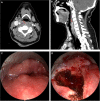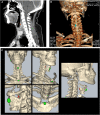Case report: Image guidance retrieval of a foreign body in retropharyngeal space
- PMID: 35965879
- PMCID: PMC9363669
- DOI: 10.3389/fsurg.2022.949964
Case report: Image guidance retrieval of a foreign body in retropharyngeal space
Abstract
Background: Ingested foreign bodies fully embedded in retropharyngeal space present a unique challenge, as they can be difficult to locate and visualize via classic transoral laryngoscopy or the transcervical approach.
Methods: We retrieved a complete extraluminal chicken bone located in the patient's retropharyngeal space at the level of the C4-C5 spine through a well-designed transcervical approach with a combination of image-guided neck navigation.
Conclusion: A combined use of image-guided neck navigation and a dedicated transcervical approach for location of a foreign body in the retropharyngeal space is practical and available for clinical application.
Keywords: case report; foreign body; head and neck; image guidance navigation; retropharyngeal space.
© 2022 Wu, Wang, Sun and Zhu.
Conflict of interest statement
The authors declare that the research was conducted in the absence of any commercial or financial relationships that could be construed as a potential conflict of interest.
Figures



Similar articles
-
Minimally invasive approach for retrieval of retropharyngeal foreign body.J Minim Access Surg. 2021 Oct-Dec;17(4):554-555. doi: 10.4103/jmas.JMAS_243_20. J Minim Access Surg. 2021. PMID: 34558431 Free PMC article.
-
Transoral videolaryngoscopic surgery with a navigation system for excision of a metastatic retropharyngeal lymph node.ORL J Otorhinolaryngol Relat Spec. 2014;76(6):357-63. doi: 10.1159/000369626. Epub 2015 Jan 27. ORL J Otorhinolaryngol Relat Spec. 2014. PMID: 25633576
-
Transcervical drainage of epidural and retropharyngeal abscess.J Clin Neurosci. 2010 May;17(5):636-8. doi: 10.1016/j.jocn.2009.07.113. Epub 2010 Feb 25. J Clin Neurosci. 2010. PMID: 20188569
-
Clinical Approaches to Migrating Ingested Foreign Bodies in the Neck.Ear Nose Throat J. 2022 Mar;101(3):181-185. doi: 10.1177/0145561320948787. Epub 2020 Aug 14. Ear Nose Throat J. 2022. PMID: 32791905 Review.
-
Needle in the Haystack: Wire Bristle Foreign Body Presenting Deep Within the Tongue Base.Ear Nose Throat J. 2023 Aug;102(8):522-526. doi: 10.1177/01455613211014079. Epub 2021 May 16. Ear Nose Throat J. 2023. PMID: 33993775 Review.
References
Publication types
LinkOut - more resources
Full Text Sources
Miscellaneous

